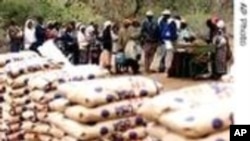The United States substantially increased its development assistance worldwide in 2008, according to the U.S. Department of State. Once again the U.S. is the largest single donor in the world. Developing nations received $26 billion in assistance from the U.S. last year, a $4.2 billion or 19 percent increase from 2007.
United States development assistance has more than tripled over the last decade. In 2008, U.S. foreign assistance disbursements were the second highest in the history of all donors – topped only by the U.S. record of $27.9 billion in 2005.
The growth of U.S. development assistance is due to expanded U.S. programs in a wide variety of areas, including global health and HIV/AIDS, humanitarian assistance, and economic growth. Assistance to the Least Developed Countries increased last year by over 40 percent to $6.9 billion from $4.8 billion in 2007.
In addition to official development assistance, the U.S. private sector, through trade, investments, remittances and grants, and charitable contributions provided billions more in support for development.
Through its foreign assistance programs, the United States seeks to promote sustainable economic growth; foster good governance; increase access to quality education; combat disease and improve public health; respond to urgent humanitarian needs; advance human rights and freedoms; prevent and respond to armed conflict; and address transnational threats such as international terrorism, human trafficking and the illegal drug trade.
The United States Government has increased both the quality and the quantity of its foreign assistance. The United States is committed to making bilateral and multilateral assistance effective and results-oriented in accordance with Paris Declaration principles and to promoting long-term and sustainable economic growth while avoiding aid-dependency.
United States development assistance has more than tripled over the last decade. In 2008, U.S. foreign assistance disbursements were the second highest in the history of all donors – topped only by the U.S. record of $27.9 billion in 2005.
The growth of U.S. development assistance is due to expanded U.S. programs in a wide variety of areas, including global health and HIV/AIDS, humanitarian assistance, and economic growth. Assistance to the Least Developed Countries increased last year by over 40 percent to $6.9 billion from $4.8 billion in 2007.
In addition to official development assistance, the U.S. private sector, through trade, investments, remittances and grants, and charitable contributions provided billions more in support for development.
Through its foreign assistance programs, the United States seeks to promote sustainable economic growth; foster good governance; increase access to quality education; combat disease and improve public health; respond to urgent humanitarian needs; advance human rights and freedoms; prevent and respond to armed conflict; and address transnational threats such as international terrorism, human trafficking and the illegal drug trade.
The United States Government has increased both the quality and the quantity of its foreign assistance. The United States is committed to making bilateral and multilateral assistance effective and results-oriented in accordance with Paris Declaration principles and to promoting long-term and sustainable economic growth while avoiding aid-dependency.













